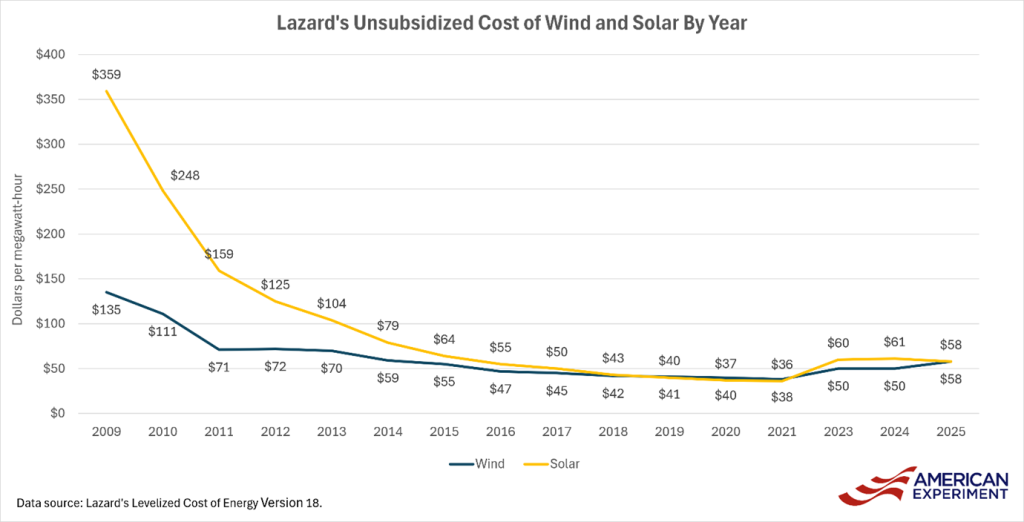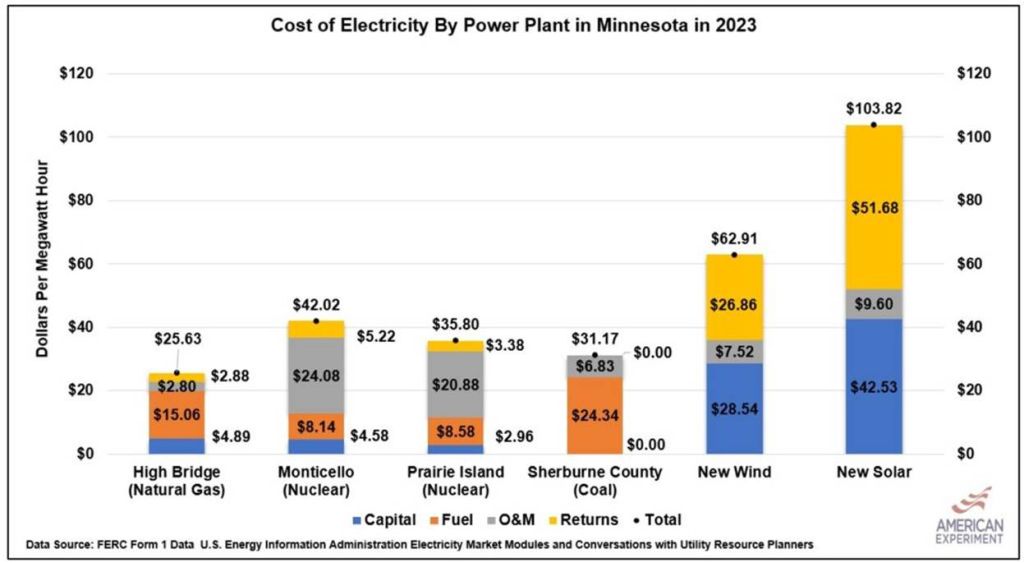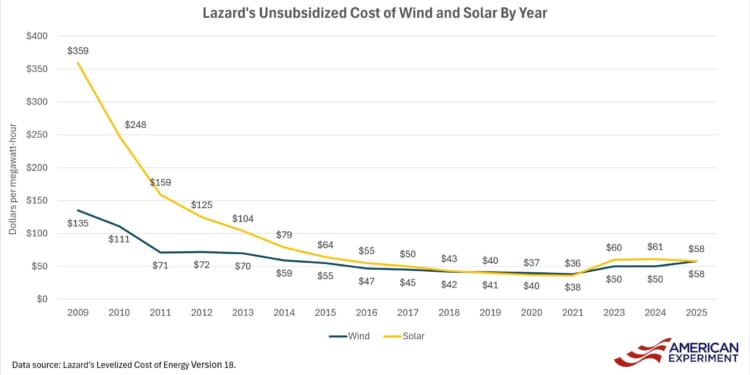A recent letter to the editor in the Star Tribune — from a Minnesota Department of Commerce official, no less — argued that “wind and sunshine are free.” Minnesotans are so often told that solar panels and wind turbines are the lowest-cost ways to generate electricity that it’s become dogma.
The truth is that wind and sunshine are free in themselves, but powering a grid on wind turbines and solar panels is far from it.
The misleading calculations of Lazard’s Levelized Cost of Energy (LCOE)
In June 2025, a headline in pv magazine blared that “solar, wind remain cheapest sources of power in U.S.” The article is based on the Levelized Cost of Energy (LCOE) from financial firm Lazard, which releases an annual analysis. For years, activists and even regulators have waved around Lazard’s charts claiming that wind and solar are “cheaper” than coal and gas.
The LCOE is an estimate of the long-term average cost of producing electricity from a power plant on a per-unit of energy basis. The calculation reflects the capital costs of building the plant, fuel costs, variable and fixed operation and maintenance costs, an assumed lifetime and the annual capacity factors.
Former policy fellow Isaac Orr wrote a four-part series in 2023 explaining how wind and solar promoters misuse the Lazard LCOE findings and wrongly suggest that these are the cheapest sources of electricity. Here is the short version:
- Lazard’s LCOE compares new wind and solar with new coal, natural gas, and nuclear — not existing resources: The U.S. electric grid is not being built from scratch, and there are many existing coal, natural gas, and nuclear plants online today. Running existing power plants through the end of their useful lifetime is cheaper because capital costs are paid off over time and are fully depreciated, leaving only the marginal costs of fuel and ongoing maintenance.
- Lazard LCOE doesn’t factor in system-wide costs: The Lazard analysis explicitly does not examine the effects of “network upgrades, transmission, congestion or other integration-related costs; permitting or other development costs,” and the “costs of complying with various environmental regulations (e.g. carbon emissions offsets or emissions control systems.” These add hidden costs.
- Wind and solar don’t provide the same reliability value to the grid: The LCOE metric was developed to compare resources that were able to provide the same reliability value to the grid. Wind and solar cannot supply reliable, dispatchable power in the same way as coal, natural gas, or nuclear power can. It isn’t apples-to-apples.
- Lazard’s LCOE is meant for financial institutions, not grid planners: The calculation does not factor in considerations the grid planners find important, including load balancing, projected utilization, capacity value, and the aforementioned reliability values.
- Capital costs for wind and solar are starting to rise: The unsubsidized capital costs for wind and solar have dropped between 2009 and 2015 but have flattened out since 2015 and ticked upward since 2021. Costs are rising due to higher material costs of components, supply chain disruptions, and federal tariffs and import restrictions. It’s possible that wind and solar have already seen the floor for how cheap they will get.

LCOE doesn’t include the cost of making the grid reliable. It ignores transmission lines, backup generation, overbuilding, battery storage, and the curtailment that happens when wind or solar produce power nobody needs. Those system costs don’t show up in glossy charts, but they show up on your electric bill.
What happens when you account for system-wide costs
Mitch Rolling, former American Experiment policy fellow, demonstrated in 2023 the unsubsidized cost of electricity from wind and solar in Minnesota from 2012 to 2023. Minnesota’s newest wind facilities now cost about $62.91 per MWh, up from $39.12 per MWh in 2019, or a 61 percent increase. New solar installations were even higher at $103.83/MWh in 2023, up 47 percent from $70.46/MWh in 2020.
Compare that to existing generation sources. Note that Sherburne County (Sherco) Unit 2 closed at the end of 2023.
New wind costs twice as much as existing coal. New solar costs 3.3 times as much as existing coal.

Then add to that the cost of additional transmission and natural gas backup power plants and the costs of replacing wind and solar generation every 20 to 25 years rather than 40 to 80 years for other types of generation. It becomes clear that Lazard’s LCOE misses a big part of the picture. One peer reviewed study suggests that including the costs of reliability increases the costs of solar between 11 and 42 times.
If wind and solar are cheap, then they don’t need subsidies or mandates
The argument that wind and solar are the cheapest forms of energy has reared its head in response to the July 4, 2025 reconciliation bill.
There are two problems with blaming the One Big Beautiful Bill Act for raising electricity prices. The first is that the subsidies for wind and solar are still in effect: the bill doesn’t remove tax credits retroactively, and phaseouts won’t start for several years. Projects must start producing electricity by the end of 2027 or by 2030 if they begin construction by next summer. It’s difficult to blame actions in the future for prices rising today, but critics like former mayor of Chicago Rahm Emanuel still make the attempt.
Second, if wind and solar are as cost competitive as wind and solar proponents claim, then losing the tax credits shouldn’t strand capital and lead to developers abandoning their projects. It’s telling that after 30 years of taxpayer dollars for wind and solar, developers have merely shifted costs to taxpayers.
Reliability has a price, and you’re paying it
If policymakers were honest about the costs of wind and solar, they would invite transparency into system-wide costs instead of citing the Lazard LCOE as gospel and repeating the tired refrain that “wind and sunshine are free.” Minnesota would keep what works, continuing to operate paid-for coal and natural gas plants through the end of their useful life, which have tremendous reliability attributes that wind and solar can’t match. And Minnesota would repeal its moratorium on new nuclear construction, to allow for zero-carbon energy generation that is reliable and dispatchable.
Until renewables can compete on a full, systemwide basis, let’s not bankrupt families chasing the mirage of “free” wind and sunshine.










